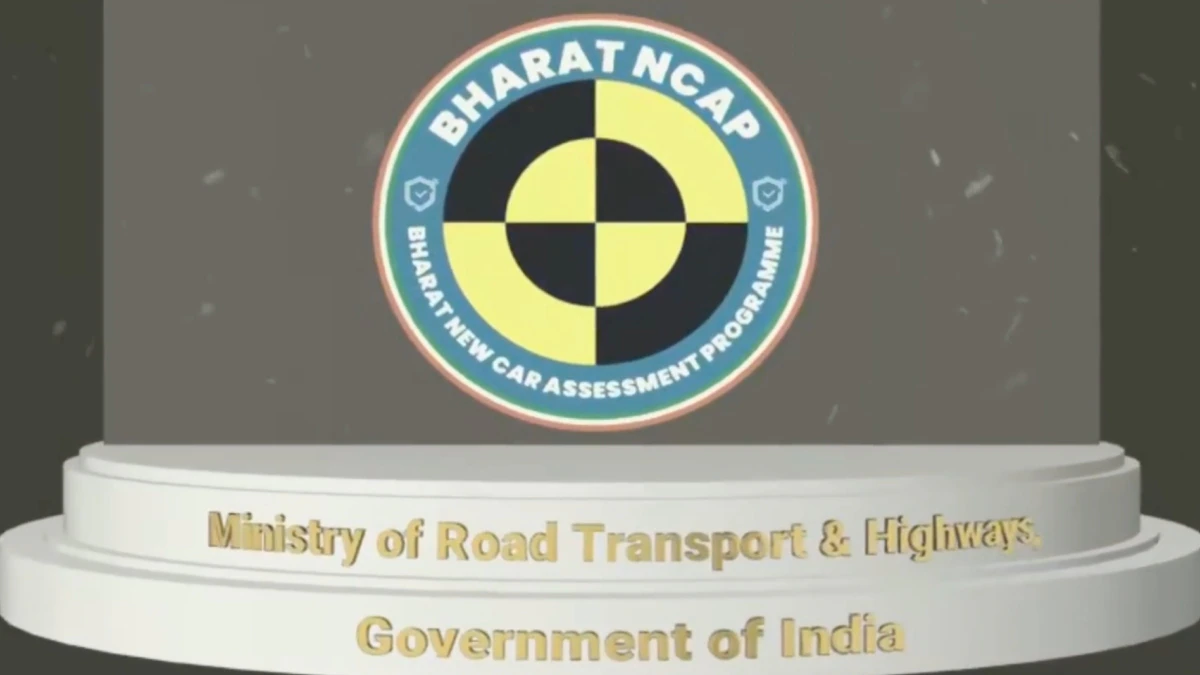Description

Copyright infringement not intended
Picture Courtesy: India Today
Context: The Bharat New Car Assessment Programme (Bharat NCAP) was launched by the Union Minister of Road Transport and Highways to enhance road safety in India. It is inspired by the Global New Car Assessment Programme (Global NCAP), aiming to promote global vehicle safety standards.
Details
Features
- Elevating Safety Standards: Bharat NCAP aims to raise the safety standards of vehicles in India, particularly those weighing up to 3.5 tonnes. This initiative emphasizes the importance of vehicle safety for both occupants and pedestrians.
- Applicable Vehicles: The program applies to passenger vehicles with a maximum of eight seats, including the driver's seat. Additionally, the gross vehicle weight (GVW) of these vehicles should not exceed 3,500 kg. This covers a wide range of cars, SUVs, and smaller commercial vehicles.
- Voluntary Participation: Car manufacturers can voluntarily participate in the Bharat NCAP. By doing so, they commit to subjecting their vehicle models to crash tests and safety evaluations to receive safety star ratings.
- Safety Star Ratings: Vehicles that participate in the program are evaluated based on their performance in crash tests and safety assessments. The outcome is represented by a safety star rating, ranging from one to five stars. This rating system provides consumers with a clear and easily understandable indication of the vehicle's safety level.
- Testing Protocol: The testing protocols for Bharat NCAP are outlined in the Automotive Industry Standard (AIS) 197. This standard defines the procedures and conditions under which the crash tests and safety assessments will be conducted.
- Safety Criteria: The safety ratings take into account several key factors:
- Adult Occupant Protection: How well the vehicle protects adult occupants during a crash.
- Child Occupant Protection: The effectiveness of child restraint systems and the vehicle's overall child safety measures.
- Safety Assist Technologies: The presence and effectiveness of safety features such as airbags, anti-lock braking systems (ABS), electronic stability control (ESC), and more.
Significance
- Empowering Consumers: By providing safety star ratings based on crash tests and assessments, Bharat NCAP empowers consumers to make more informed decisions when purchasing vehicles. These ratings give consumers a clear understanding of the safety levels of different models, enabling them to prioritize safety in their buying choices.
- Promoting Healthy Competition: The program encourages healthy competition among Original Equipment Manufacturers (OEMs) to design and manufacture safer vehicles. Manufacturers striving to achieve higher safety star ratings are likely to incorporate advanced safety features, leading to continuous improvement in vehicle safety standards.
- Elevating Vehicle Safety: Bharat NCAP plays a pivotal role in elevating the safety and quality standards of vehicles in India. Manufacturers are prompted to enhance safety features and structural integrity, resulting in vehicles that are better equipped to protect occupants and pedestrians in the event of a crash.
- Contributing to Road Safety Improvement: The improved safety standards brought about by Bharat NCAP contribute to overall road safety improvement. Safer vehicles can help reduce the severity of accidents and minimize injuries, ultimately saving lives and reducing the societal burden of road accidents.
- Global Automobile Manufacturing Hub: As Bharat NCAP encourages the manufacturing of vehicles that meet global safety standards, it aligns with India's aspiration to become a global hub for automobile manufacturing. Safer vehicles produced in India can gain a competitive edge in international markets, bolstering the country's reputation in the automotive industry.
- Safeguarding Citizens' Lives: At its core, Bharat NCAP is about protecting the lives of citizens. By promoting safer vehicles, the program contributes to a significant reduction in fatalities and injuries resulting from road accidents. This aligns with the larger societal goal of safeguarding lives and ensuring a safer road environment for everyone.

Conclusion
- The Bharat NCAP represents a significant stride toward enhancing road safety in India through improved vehicle safety standards and informed consumer choices. It requires sustained efforts and collaboration to ensure its effectiveness in reducing road accidents and safeguarding lives.
Must Read Articles:
ROAD SAFETY WEEK: https://www.iasgyan.in/daily-current-affairs/road-safety-week-31
Road Accidents in India: https://iasgyan.in/daily-current-affairs/road-accidents-in-india
|
PRACTICE QUESTION
Q. What is the significance of road safety in India, and what are the key challenges the country faces in achieving it? What strategies and initiatives can be implemented to pave the way forward toward a safer road environment for all?
|
https://pib.gov.in/PressReleasePage.aspx?PRID=1951030













